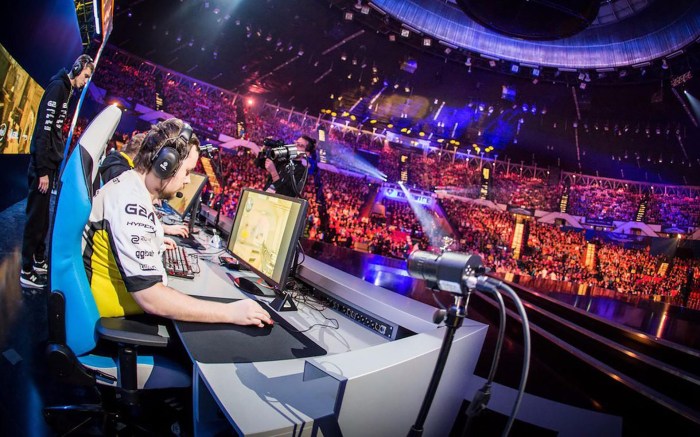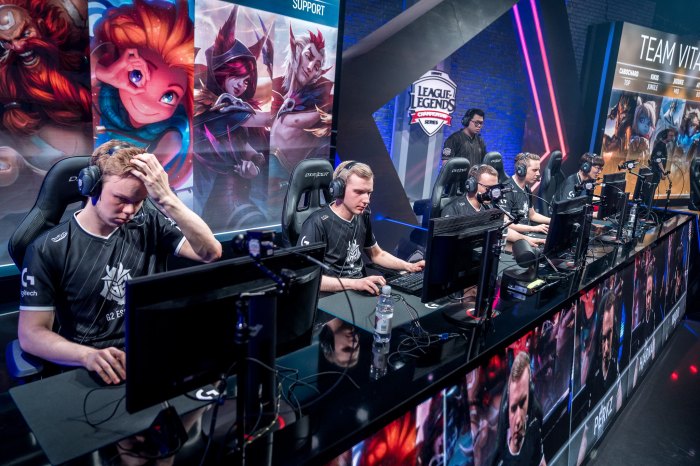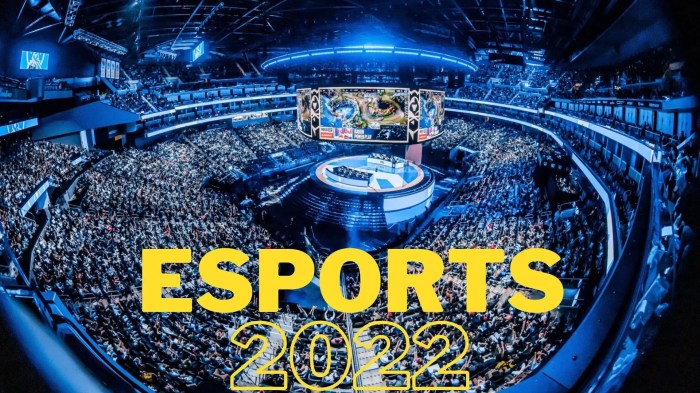Esports tournaments are exploding in popularity, transforming the way we view competitive gaming. From humble beginnings in LAN cafes to massive stadium events broadcast globally, these competitions showcase incredible skill, teamwork, and strategic depth. This exploration delves into the intricate workings of esports tournaments, covering everything from tournament formats and prize pools to player dynamics and the future of the industry.
We’ll unpack the complex world of sponsorships, game rules, and the crucial role of community engagement in shaping the vibrant esports landscape.
We’ll examine different tournament structures, exploring the advantages and disadvantages of various formats like single-elimination and round-robin. We’ll also look at how prize money is distributed and the innovative sponsorship models that fuel these high-stakes events. Beyond the mechanics, we’ll discuss the importance of team synergy, player roles, and the production elements that bring these tournaments to a global audience.
Finally, we’ll gaze into the crystal ball, predicting future trends and challenges facing the exciting world of competitive gaming.
Tournament Structure and Formats

So, you wanna run an esports tournament? First things first: you need a solid format. Choosing the right structure can make or break your event, impacting everything from player engagement to overall tournament length. Let’s break down some popular options and what makes them tick.
Different tournament formats cater to different needs and scales. A smaller, more casual tournament might work well with a single-elimination bracket, while a larger, more prestigious event might require a more complex structure like a double-elimination or round-robin format. The choice depends heavily on the number of participants, the time available, and the overall goals of the tournament.
Esports Tournament Formats Compared
This table compares three common esports tournament formats. Understanding their advantages and disadvantages is crucial for choosing the best fit for your event.
| Format Name | Description | Advantages | Disadvantages | Popular Games Used |
|---|---|---|---|---|
| Single-Elimination | Teams play a single match; a loss eliminates them from the tournament. The bracket progresses until a champion is crowned. | Simple to understand and manage; relatively short tournament duration. | One bad game can eliminate a strong team; less opportunity for teams to recover from early losses. | Many fighting games (e.g., Street Fighter, Mortal Kombat), some MOBAs (early rounds) |
| Double-Elimination | Teams play in two brackets: winners and losers. A loss in the winners’ bracket sends a team to the losers’ bracket. Teams must win multiple matches to be crowned champion. | Gives teams a second chance; more matches, potentially more exciting for viewers. | Longer tournament duration; more complex to manage. | Fighting games (e.g., Tekken, Super Smash Bros.), MOBAs (e.g., Dota 2, League of Legends – often in smaller regional qualifiers) |
| Round-Robin | Each team plays every other team once (or multiple times). Standings are determined by wins and losses. Top teams then advance to playoffs (often single or double elimination). | Fairer assessment of team skill; every match matters. | Very long tournament duration; requires a large time commitment from players and organizers. | Many strategy games (e.g., StarCraft II, some MOBAs – often in larger leagues) |
The Role of Seeding in Esports Tournaments
Seeding is the process of ranking teams before the tournament begins based on their prior performance or ranking. This is crucial for maintaining competitive balance and preventing early upsets of top teams.
Proper seeding helps ensure that strong teams don’t meet each other too early in the tournament. Imagine the EVO fighting game championships placing two top 8 players against each other in the first round – it would be a waste of talent and reduce the excitement for the fans. By strategically placing higher-ranked teams in different parts of the bracket, organizers maximize the likelihood of exciting matchups in later rounds.
This also helps create a more engaging and predictable tournament experience for viewers, while still allowing for upsets to occur organically.
Creating a 16-Team Tournament Bracket
Let’s say we’re designing a bracket for a 16-team esports competition. We’ll assume a single-elimination format for simplicity. First, we seed the teams 1-16 based on their rankings. Then, we create a bracket using a standard double-elimination format. The highest-seeded team (1) plays the lowest-seeded team (16), the second-highest (2) plays the second-lowest (15), and so on.
Winners advance to the next round, and losers are eliminated. This process continues until a single champion remains.
For example, team 1 would play team 16 in round one. The winner would then advance to round two to play the winner of the match between team 8 and team 9. This pattern continues until a champion is crowned. Visualizing this with a bracket diagram would be helpful, but as requested, I’ll leave that to your imagination! The key is to ensure that the seeding process accurately reflects team strength and that the bracket is constructed in a balanced way to minimize the chance of early upsets of top contenders.
Game Selection and Tournament Rules: Esports Tournaments

Choosing the right game and establishing clear, fair rules are crucial for a successful esports tournament. The selection process often involves considering game popularity, spectator appeal, and the availability of skilled players. Equally important is creating a rule set that ensures competitive balance and prevents disputes. This section will delve into the specifics of game selection and rule creation, using examples from established esports titles.
League of Legends and Counter-Strike: Global Offensive Rule Comparisons
League of Legends (LoL) and Counter-Strike: Global Offensive (CS:GO) represent distinct genres within esports, leading to significant differences in their tournament rule sets. LoL, a MOBA (Multiplayer Online Battle Arena), emphasizes strategic team composition, objective control, and macro-level gameplay. CS:GO, a first-person shooter (FPS), prioritizes individual aim, tactical positioning, and precise execution. These differences are reflected in the rules governing each game.
For instance, LoL tournaments typically have extensive rules regarding champion selection (bans and picks), map rotations, and pauses, reflecting the complexity and length of matches. CS:GO tournaments, while also having map vetoes, focus more on rules concerning equipment, anti-cheat measures, and in-game communication restrictions. The penalties for rule violations also differ, with LoL potentially involving warnings, point deductions, or even disqualification for serious infractions like griefing, while CS:GO might focus more on bans for cheating or exploiting game mechanics.
The Impact of Patch Updates and Game Balance on Competitive Play
Patch updates and game balance are paramount in competitive esports. Game developers constantly release updates that introduce new content, adjust character/weapon stats, and fix bugs. These updates can significantly impact the meta (the prevailing strategies and tactics), potentially rendering previously dominant strategies obsolete. A poorly balanced game can lead to a less diverse and engaging tournament, as one team composition or strategy may become overwhelmingly dominant.
For example, a significant buff to a particular champion in LoL could lead to that champion’s near-universal selection, eliminating strategic depth. Similarly, an overpowered weapon in CS:GO could skew the game towards aggressive strategies, reducing tactical diversity. Tournament organizers often work closely with game developers to ensure that the game version used in a tournament is stable and relatively balanced, minimizing the impact of unforeseen changes.
Sometimes, tournaments are even held on a specific “patch” to ensure consistent gameplay across the competition.
Hypothetical Esports Tournament Rules: Project Chimera
Project Chimera, a hypothetical team-based arena shooter, will utilize a 5v5 format. Map selection will be handled via a best-of-three veto system, with each team banning one map and the remaining map being randomly selected. A total of three unique maps will be available for selection. Weapon bans will not be implemented to maintain gameplay diversity, but specific attachments may be restricted to prevent overpowered loadouts.
Penalties will range from warnings for minor infractions (e.g., unsportsmanlike conduct) to temporary suspensions or permanent bans for severe offenses such as cheating or match-fixing. Points will be awarded based on match wins, with bonus points awarded for swift victories (e.g., 2-0 sweeps). A detailed points system will be implemented to ensure fair ranking and advancement throughout the tournament bracket.
The use of unauthorized third-party software will result in immediate disqualification.
Tournament Logistics and Production

Pulling off a successful esports tournament, even a small one, requires meticulous planning and execution. It’s not just about the games; it’s about creating a smooth, engaging experience for both players and viewers. This involves everything from venue selection to managing the live stream, and ensuring everything runs like clockwork.Planning and executing a small-scale esports tournament involves several key steps.
Each stage is crucial for a seamless event.
Tournament Planning and Execution
A step-by-step guide for planning and executing a small-scale esports tournament could look something like this:
- Define Scope and Budget: Determine the game, number of participants, prize pool, and overall budget. This initial step sets the foundation for all subsequent decisions.
- Venue Selection and Setup: Choose a suitable venue with adequate internet connectivity, power, and seating for players and spectators (if applicable). Consider factors like accessibility and parking.
- Registration and Player Management: Establish a clear registration process, including deadlines and player verification. Use a platform to manage player information and bracket generation.
- Technical Setup and Testing: Test all hardware and software (computers, internet connection, streaming equipment, microphones) thoroughly before the tournament. This prevents technical issues during the event.
- Marketing and Promotion: Promote the tournament through social media, gaming communities, and relevant websites. Create engaging content to attract participants and viewers.
- Tournament Day Execution: Manage player check-in, ensure smooth transitions between matches, and address any technical or logistical problems that may arise.
- Post-Tournament Wrap-Up: Gather feedback from players and viewers. Analyze what went well and what could be improved for future events. This feedback is crucial for continuous improvement.
The Role of Commentators and Casters
Commentators and casters are vital for enhancing the viewer experience. They provide context, analysis, and excitement, transforming a simple match into a compelling narrative. Good casters build anticipation, explain complex game mechanics in an accessible way, and connect with the audience through engaging commentary. Think of them as the storytellers of the esports world. For example, a caster might highlight a player’s strategic decision, explain the significance of an objective taken, or build suspense before a crucial team fight.
Their skill in connecting with the audience and providing insightful commentary can significantly impact the viewership and enjoyment of the tournament.
Streaming Platforms and Technologies
Streaming platforms and technologies are the backbone of modern esports tournaments. Platforms like Twitch, YouTube Gaming, and Facebook Gaming provide the infrastructure for broadcasting the event to a global audience. They offer features like chat integration, allowing for real-time viewer interaction and engagement. The use of high-quality cameras, microphones, and production software ensures a professional and immersive viewing experience.
Accessibility features, such as closed captions and multiple language options, are becoming increasingly important to broaden the reach and inclusivity of esports tournaments. For example, Twitch’s built-in chat function enables viewers to communicate with each other and the casters, creating a sense of community and boosting engagement. Similarly, the use of high-quality streaming equipment allows for clear visuals and audio, which is essential for an enjoyable viewing experience.
Finally, offering closed captions allows for broader accessibility and inclusivity for viewers who are deaf or hard of hearing.
Audience Engagement and Community Building

Building a thriving esports tournament isn’t just about the games; it’s about cultivating a passionate community that feels invested in the entire experience. A successful tournament hinges on creating a buzz, fostering interaction, and making attendees and online viewers feel like they’re part of something special. This involves a multi-pronged approach encompassing social media engagement, in-game events, and proactive community management.Effective audience engagement significantly impacts the overall success and longevity of an esports tournament.
A highly engaged audience translates to increased viewership, sponsorships, and overall tournament revenue. Moreover, a positive and active community contributes to the tournament’s brand reputation and fosters a sense of loyalty among fans. This loyalty, in turn, can lead to sustained growth and future tournament success.
Social Media Campaigns for Increased Audience Engagement
A robust social media strategy is crucial for reaching a wide audience and maintaining consistent engagement. This involves creating compelling content across various platforms like Twitter, Instagram, TikTok, and Twitch. For example, a pre-tournament countdown campaign using engaging visuals and behind-the-scenes content can generate excitement. During the tournament, live updates, polls, and Q&A sessions with players can keep the audience actively involved.
Post-tournament, highlight reels and interviews can extend the engagement and build anticipation for future events. Consider using relevant hashtags to increase visibility and participation. Successful campaigns often incorporate interactive elements, like contests or giveaways, to incentivize audience participation and build a sense of community. For example, a popular strategy is to offer exclusive merchandise or meet-and-greets to lucky winners.
In-Game Events to Enhance Viewer Experience
Integrating in-game events directly into the tournament stream can significantly boost audience participation. These events could include interactive polls during breaks in gameplay, where viewers vote on decisions or predict outcomes. Real-time leaderboards showcasing viewer participation in these events can further enhance engagement and create a sense of competition among the audience. Additionally, incorporating challenges or mini-games that viewers can participate in through a dedicated platform or social media could add another layer of interaction.
The key is to ensure these in-game events are seamlessly integrated and don’t disrupt the main tournament flow. For example, the popular game
League of Legends* often incorporates viewer-driven polls to decide aspects of the broadcast, enhancing viewer experience and fostering a sense of shared participation.
Community Management and Fostering a Positive Atmosphere, Esports tournaments
Effective community management is paramount for cultivating a positive and thriving online community around the esports tournament. This involves actively moderating online forums, social media channels, and live chat streams to ensure respectful and constructive interactions. Promptly addressing negative comments or disputes can prevent them from escalating and maintaining a healthy environment. Regularly engaging with the community through Q&A sessions, behind-the-scenes content, and feedback opportunities builds trust and strengthens the connection between the tournament organizers and the audience.
This proactive approach fosters a sense of belonging and encourages ongoing participation. Dedicated community managers should be responsible for monitoring and responding to community interactions, ensuring a welcoming environment for all. They can also help to identify and celebrate active community members.
Impact of Online Communities and Fan Interaction on Tournament Success
Strong online communities directly contribute to the overall success of esports tournaments. Active fan engagement generates excitement and buzz, attracting new viewers and sponsors. Positive word-of-mouth marketing within online communities can significantly increase tournament reach and brand awareness. Furthermore, a strong online community provides valuable feedback to tournament organizers, allowing for continuous improvement and adaptation to audience preferences.
For example, a highly active community on Twitch or Discord can offer suggestions on tournament formats, game selection, and even branding. This feedback loop ensures the tournament remains relevant and appealing to its core audience, contributing to its long-term success. The community itself can become a powerful marketing tool, with engaged fans sharing highlights and promoting the tournament across their networks.
Q&A
What are the typical roles in an esports team?
Roles vary by game, but common examples include: carry (damage dealer), support (healer/utility), tank (absorbs damage), mid-laner (control/mid-game influence), jungler (map control/ganking).
How do esports tournament organizers make money?
Revenue streams include sponsorship deals, media rights, ticket sales (for in-person events), merchandise sales, and in-game item sales (some games).
How are players selected for esports tournaments?
Selection methods vary. Some tournaments use open qualifiers where anyone can compete, while others invite teams based on their ranking or previous performance.
What are some common penalties in esports tournaments?
Penalties can include warnings, point deductions, disqualification from matches or the entire tournament, and even bans from future events for violations of rules (e.g., cheating, unsportsmanlike conduct).
